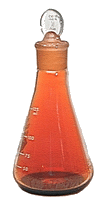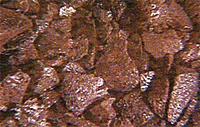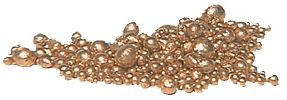The Elements
Elements are pure substances. The atoms of each element are chemically distinct
and different from those of any other element. Approximately 110 elements are
now known. By 1980, 106 of these had been unequivocally characterized and accepted
by the International Union of Pure and Applied Chemistry (IUPAC). Since that
time, elements 107 and 109 have been identified among the products of a nuclear
reaction. The search for new elements continues in many laboratories around
the world; new elements may be announced at any time.
A. Names and Symbols of the Elements
Each element has a name. Many of these names are already familiar to you - gold, silver, copper, chlorine, platinum, carbon, oxygen, and nitrogen. The names themselves are interesting. Many refer to a property of the element. The Latin name for gold is aurum, meaning "shining dawn." The Latin name for mercury, hydrargyrum, means "liquid silver."
The practice of naming an element after one of its properties continues. Cesium was discovered in 1860 by the German chemist Bunsen (the inventor of the Bunsen burner). Because this element imparts a blue color to a flame, Bunsen named it cesium from the Latin word caesius, meaning "sky blue."
Other elements are named for people. Curium is named for Marie Curie (1867-1934), a pioneer in the study of radioactivity. Marie Curie, a French scientist of Polish birth, was awarded the Nobel Prize in Physics in 1903 for her studies of radioactivity. She was also awarded the Nobel Prize in Chemistry in 1911 for her discovery of the elements polonium (named after Poland) and radium (Latin, radius, "ray").
Some elements are named for places. The small town of Ytterby in Sweden has four elements named for it: terbium, yttrium, erbium, and ytterbium. Californium is another example of an element named for the place where it was first observed. This element does not occur in nature. It was first produced in 1950 in the Radiation Laboratory at the University of California, Berkeley, by a team of scientists headed by Glenn Seaborg. Seaborg was also the first to identify curium at the metallurgical laboratory at the University of Chicago (now Argonne National Laboratory) in 1944. Seaborg himself was named a Nobel laureate in 1951 in honor of his pioneering work in the preparation of other unknown elements.
Each element has a symbol,one or two letters that represent the element much as your initials represent you. The symbol of an element represents one atom of that element. For 14 of the elements, the symbol consists of one letter. With the possible exceptions of yttrium (Y) and vanadium (V), you are probably familiar with the names of all elements having one-letter symbols. These elements are listed in Table 3.1. For 12 of these elements, the symbol is the first letter of the name.
Potassium was discovered in 1807 and named for potash, the substance from which potassium was first isolated. Potassium's symbol, K, comes from kalium, the Latin word for potash. Tungsten, discovered in 1783, has the symbol W, for wolframite, the mineral from which tungsten was first isolated.
|
|
Most other elements have two-letter symbols. In these two-letter symbols, the first letter is always capitalized and the second is always lowercased. Eleven elements have names (and symbols) beginning with the letter C. One of these, carbon, has a one-letter symbol, C. The other ten have two-letter symbols (see Table 3.2).
|
|
B. Lists of the Elements
While you study chemistry, you will often need a list of the elements. To
see a list of the elements click here. The list includes the symbol, the
atomic number, and the atomic weight of the element. The significance of atomic
numbers and weights will be discussed in Chapter 4. For now it is sufficient
to know that each element has a number between 1 and 110 called its atomic
number. This number is as unique to the element as its name or symbol.
The second list, called the periodic table, arranges the elements in order of increasing atomic number in rows of varying length. The significance of the length of the row and the relation among elements in the same row or column will be discussed in Chapter 5. The periodic table appears by clicking on the inside of the front cover of this text. Throughout the text we will refer to the periodic table, because it contains an amazing amount of information. For now you need only be aware that elements in the same column have similar properties and that the heavy stair-step line that crosses the table diagonally from boron (B) to astatine (At) separates the metallic elements from the nonmetallic elements. The periodic table is also shown in Figure 3.3. The screened areas mark the elements you will encounter most often in this text.
1. Metals and nonmetals
Metals appear below and to the left of the heavy diagonal line in the periodic table. The characteristic properties of a metal are:
Nonmetals vary more in their properties than do metals; some may even have one or more of the metallic properties listed. Some nonmetals are gaseous; chlorine and nitrogen are gaseous nonmetals. At 20°C one nonmetal, bromine, is a liquid, and others are solids - for example, carbon, sulfur, and phosphorus.
| Bromine |
 |
| Carbon |  |
| Sulfur |  |
| Red Phosphorus |  |
C. Distribution of the Elements
The known elements are not equally distributed throughout the world. Only 91 are found in either the Earth's crust, oceans, or atmosphere; the others have been produced in laboratories. Traces of some but not all of these elements have been found on Earth or in the stars. The search for the others continues. You might read of its success or of the isolation of new elements as you study this text.
|
|
Table 3.3 lists the 18 elements that are most abundant in the Earth's crust, oceans, and atmosphere, along with their relative percentages of the Earth's total mass. One of the most striking points about this list is the remarkably uneven distribution of the elements (see Figure 3.4). Oxygen is by far the most abundant element. It makes up 21% of the volume of the atmosphere and 89% of the mass of water. Oxygen in air, water, and elsewhere constitutes 49.2% of the mass of the Earth's crust, oceans, and atmosphere. Silicon is the Earth's second most abundant element (25.7% by mass). Silicon is not found free in nature but occurs in combination with oxygen, mostly as silicon dioxide (SiO2), in sand, quartz, rock crystal, amethyst, agate, flint, jasper, and opal, as well as in various silicate minerals such as granite, asbestos, clay, and mica. Aluminum is the most abundant metal in the Earth's crust (7.5%). It is always found combined in nature. Most of the aluminum used today is obtained by processing bauxite, an ore that is rich in aluminum oxide. These three elements (oxygen, silicon, and aluminum) plus iron, calcium, sodium, potassium, and magnesium make up more than 97% of the mass of the Earth's crust, oceans, and atmosphere. Another surprising feature of the distribution of elements is that several of the metals that are most important to our civilization are among the rarest; these metals include lead, tin, copper, gold, mercury, silver, and zinc.
| FIGURE 3.4 Relative percentages by mass of elements in the Earth's crust, oceans, and atmosphere. |
The distribution of elements in the cosmos is quite different from that on Earth. According to present knowledge, hydrogen is by far the most abundant element in the universe, accounting for as much as 75% of its mass. Helium and hydrogen together make up almost 100% of the mass of the universe.
Table 3.4 lists the biologically important elements - those found in a normal, healthy body. The first four of these elements - oxygen, carbon, hydrogen, and nitrogen--make up about 96% of total body weight (see Figure 3.5). The other elements listed, although present in much smaller amounts, are nonetheless necessary for good health.
|
|
| FIGURE 3.5 The distribution of elements (by mass) in the human body. |
D.How Elements Occur in Nature
Elements occur as single atoms or as groups of atoms chemically bonded together. The nature of these chemical bonds will be discussed in Chapter 7.
Groups of atoms bonded together chemically are called molecules
or formula units.
Molecules may contain atoms of a single element, or they may contain atoms of different elements (in which case the molecule is of a compound.) Just as an atom is the smallest unit of an element, a molecule is the smallest unit of a compound - that is, the smallest unit having the chemical identity of that compound.
Let us consider how the elements might be categorized by the way they are found in the universe.
1. The noble gases
Only a few elements are found as single, uncombined atoms; Table 3.5 lists these elements. Under normal conditions, all of these elements are gases; collectively, they are known as the noble gases.
They are also called monatomic gases, meaning that they exist, uncombined, as single atoms (mono means "one"). The formula for each of the noble gases is simply its symbol. When the formula of helium is required, the symbol He is used. The subscript 1 is understood.
| Symbol | Element |
|---|---|
| helium | |
| neon | |
| argon | |
| krypton | |
| xenon | |
| radon |
2. Metals
Pure metals are treated as though they existed as single, uncombined atoms even
though a sample of pure metal is an aggregate of billions of atoms. Thus, when
the formula of copper is required, its symbol, Cu, is used to mean one atom
of copper.
 |
|
Copper Metal
|
3. Nonmetals
Some nonmetals exist, under normal conditions of temperature and pressure, as
molecules containing two, four, or eight atoms. Those nonmetals that occur as
diatomic (two-atom)molecules are listed in Table 3.6. Thus, we use O2
as the formula for oxygen, N2 for nitrogen, and so on. Among the
nonmetals, sulfur exists as S8 and phosphorus is found as P4.
For other nonmetals (those not listed in Table 3.5 or 3.6) a monatomic formula
is used - for example, As for arsenic and Se for selenium.
| Formula | Name | Normal state |
|---|---|---|
| hydrogen | colorless gas | |
| nitrogen | colorless gas | |
| oxygen | colorless gas | |
| fluorine | pale yellow gas | |
| chlorine | greenish yellow gas | |
| bromine | dark red liquid | |
| iodine | violet black solid |
4. Compounds
Although many elements can occur in the uncombined state, all elements except some of the noble gases are also found combined with other elements in compounds. In Section 3.1 we defined a compound as a substance that can be decomposed by ordinary chemical means. A compound can also be defined as a pure substance that contains two or more elements. The composition of a compound is expressed by a formula that uses the symbols of all the elements in the compound. Each symbol is followed by a subscript, a number that shows how many atoms of the element occur in one molecule (the simplest unit) of the compound; the subscript 1 is not shown. Water is a compound with the formula H2O, meaning that one molecule (or formula unit) of water contains two hydrogen atoms and one oxygen atom. The compound sodium hydrogen carbonate has the formula NaHCO3, meaning that a single formula unit of this compound contains one atom of sodium, one atom of hydrogen, one atom of carbon, and three atoms of oxygen. Notice that the symbols of the metals in sodium hydrogen carbonate are written first, followed by the nonmetals, and that, of the nonmetals, oxygen is written last. This order is customary.
Sometimes a formula will contain a group of symbols enclosed in parentheses as, for example, Cu(NO3)2. The parentheses imply that the group of atoms they enclose act as a single unit. The subscript following the parenthesis means that the group is taken two times for each copper atom.
 |
|
Copper Nitrate
|
The properties of a compound are quite unlike those of the elements from which it is formed. This fact is apparent if we compare the properties of carbon dioxide, CO2 (a colorless gas used in fire extinguishers), with those of carbon (a black, combustible solid) and oxygen (a colorless gas necessary for combustion). The properties of compounds are discussed in greater detail in Chapter 6.